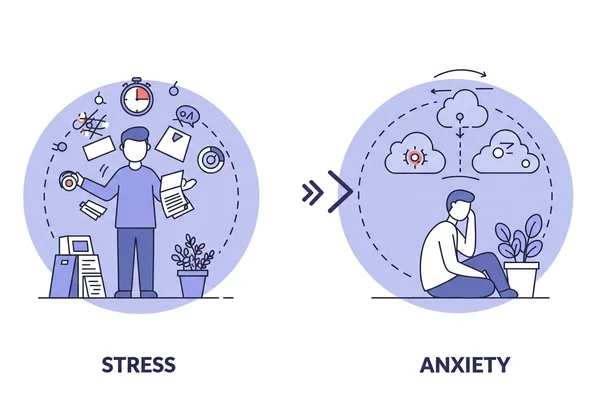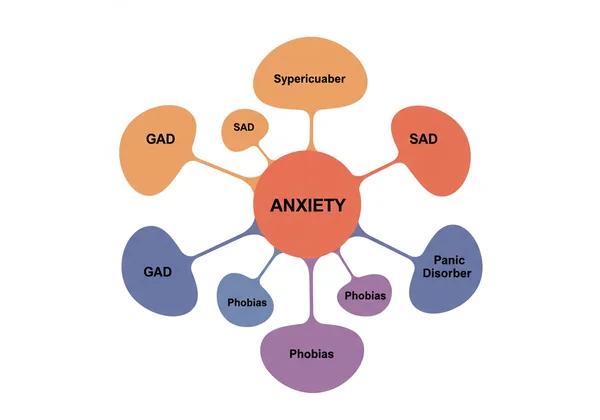Free Online Anxiety Test: Symptoms, Types & How to Manage It
Feeling overwhelmed or constantly worried? You're not alone. Navigating the world of anxiety can feel confusing, especially when trying to distinguish it from everyday stress. This ultimate guide provides a comprehensive overview of anxiety, exploring its various forms and offering actionable insights into understanding your mental well-being. Do I have an anxiety test? It's a question many people ask themselves, and finding a clear, science-backed answer is the first step toward managing those feelings. Let’s explore the fundamentals of anxiety and how you can begin your journey to clarity with a reliable online anxiety test.

What is Anxiety? Understanding the Basics
At its core, anxiety is your body's natural response to stress. It’s a feeling of fear or apprehension about what’s to come. The first day of a new job, giving a speech, or facing a difficult test can cause most people to feel fearful and nervous. However, if your feelings of anxiety are extreme, last for longer than six months, and are interfering with your life, you may have an anxiety disorder. Understanding its roots is key to managing it effectively.
Anxiety vs. Stress: What's the Difference?
Many people use the terms "stress" and "anxiety" interchangeably, but they are not the same. Stress is typically a response to an external cause, such as a tight deadline at work or an argument with a friend. The symptoms of stress usually disappear after the stressor is gone. Anxiety, on the other hand, is a person's specific reaction to stress; its origin is internal. It’s the persistent, excessive worrying that doesn't go away even in the absence of a stressor.
The Role of the Brain and Body in Anxiety
When you perceive a threat, your brain’s amygdala—the emotional processing center—triggers the fight-or-flight response. This floods your body with adrenaline and cortisol, preparing you to face danger. This system is essential for survival. In individuals with anxiety, however, this alarm system can become overly sensitive. It may activate in response to non-threatening situations, creating a prolonged state of high alert that leaves you feeling drained and on edge.
Common Anxiety Symptoms: What to Look For
Anxiety manifests in many ways, affecting both your mind and body. Recognizing these signs is a crucial step in understanding what you're experiencing. While everyone's experience is unique, certain patterns are common. If you notice several of these symptoms consistently, it might be time to explore them further with a free anxiety test.
Physical Signs of Anxiety
Your body often keeps score of your emotional state. Physical symptoms can be some of the first and most noticeable indicators of anxiety. These can include:
- Increased Heart Rate: A pounding or racing heart, even when you are resting.
- Shortness of Breath: Feeling like you can't get enough air.
- Muscle Tension: Persistent tightness, especially in the neck, shoulders, and back.
- Fatigue: Feeling tired and drained, even after a full night's sleep.
- Digestive Issues: Stomachaches, nausea, or irritable bowel syndrome (IBS).
- Headaches: Chronic tension headaches or migraines.
Emotional and Cognitive Symptoms
Beyond the physical, anxiety deeply impacts your thoughts and feelings. These symptoms can be just as debilitating and often create a cycle of worry that is hard to break. Look out for:
-
Excessive Worry: Uncontrollable and often irrational fears about everyday situations.
-
Irritability: Feeling easily annoyed or having a short temper.
-
Restlessness: A feeling of being "on edge" or unable to relax.
-
Difficulty Concentrating: Finding it hard to focus on tasks or remember things.
-
Catastrophizing: Automatically assuming the worst-case scenario will happen.

Types of Anxiety: Exploring Different Disorders
Anxiety is not a one-size-fits-all condition. It is an umbrella term for several distinct disorders, each with its own unique set of symptoms and triggers. Understanding these different types can help you pinpoint the nature of your worries and seek the right kind of support.
Generalized Anxiety Disorder (GAD)
Generalized Anxiety Disorder (GAD) is characterized by chronic, exaggerated worry about a wide range of topics, including health, work, social interactions, and everyday routines. This worry is often disproportionate to the actual circumstance and difficult to control. Many online screening tools, including the scientifically validated GAD-7 scale, are designed to measure the severity of these generalized symptoms. A generalized anxiety test can provide valuable insights if this sounds familiar.
Social Anxiety Disorder (SAD)
Also known as social phobia, Social Anxiety Disorder involves an intense fear of being scrutinized or judged by others in social or performance situations. This can lead to avoidance of social gatherings, public speaking, or even simple interactions like making eye contact. The underlying fear is often rooted in a worry about embarrassment or humiliation.
Panic Disorder and Panic Attacks
Panic Disorder is defined by recurrent and unexpected panic attacks. A panic attack is a sudden surge of overwhelming fear that comes on for no apparent reason, accompanied by intense physical symptoms like a racing heart, chest pain, dizziness, and a feeling of impending doom. Those with panic disorder often live in fear of their next attack.
Other Anxiety-Related Conditions
The spectrum of anxiety also includes other conditions like specific phobias (an intense, irrational fear of a specific object or situation), separation anxiety (fear of being separated from people to whom one is attached), and agoraphobia (fear of being in situations where escape might be difficult).

Managing Anxiety: Strategies for Coping and Relief
The good news is that anxiety is manageable. Gaining control starts with understanding your triggers and equipping yourself with effective coping strategies. While an anxiety level test can give you a baseline, these techniques can empower you to actively manage your symptoms day-to-day.
Immediate Coping Techniques
When you feel anxiety rising, having a few go-to techniques can make an immediate difference. These methods help regulate your nervous system and bring you back to the present moment.
- Deep Breathing: Practice "box breathing." Inhale for four seconds, hold for four, exhale for four, and hold for four. Repeat until you feel calmer.
- The 5-4-3-2-1 Grounding Method: Name five things you can see, four things you can feel, three things you can hear, two things you can smell, and one thing you can taste.
- The 3-3-3 Rule: Look around and name three things you see. Then, name three sounds you hear. Finally, move three parts of your body—your ankle, fingers, or arm.
Lifestyle Adjustments for Long-Term Well-being
For sustainable, long-term relief, integrating healthy habits into your daily life is crucial. These lifestyle changes can build your resilience against anxiety over time.
- Regular Exercise: Physical activity is a powerful anxiety reducer. Aim for at least 30 minutes of moderate exercise most days.
- Balanced Diet: Limit caffeine, alcohol, and processed foods, which can trigger or worsen anxiety. Focus on whole foods rich in nutrients.
- Prioritize Sleep: Aim for 7-9 hours of quality sleep per night. A consistent sleep schedule helps regulate mood.
- Mindfulness and Meditation: Regular practice can help you become more aware of your thought patterns without judgment.
When to Seek Professional Help and Treatment Options
Self-help strategies are powerful, but sometimes they aren't enough. If anxiety is significantly impacting your daily life, it is a sign of strength to seek professional support. A therapist can offer treatments like Cognitive-Behavioral Therapy (CBT), which is highly effective for anxiety. A doctor can also discuss medication options if appropriate.

Disclaimer: This article is for informational purposes only and does not constitute medical advice. The test on our website is a screening tool, not a diagnostic instrument. Please consult a qualified healthcare professional for any health concerns.
Your Journey to Understanding and Managing Anxiety Starts Here
Anxiety is a complex but common human experience. By understanding its symptoms, types, and the strategies available to manage it, you can move from a place of fear to one of empowerment. Knowledge is the first step, and self-assessment is the second. Recognizing how anxiety affects you personally is the key to unlocking the right path forward.
Ready to gain confidential, personalized insights into your anxiety? Take the free test on our homepage. It takes less than three minutes, is completely anonymous, and provides an instant analysis to help you take the next step with confidence.
Frequently Asked Questions About Anxiety
Do I Have Anxiety or Just Stress?
Stress is a short-term response to a recognizable threat, while anxiety is more persistent and can linger without a clear trigger. If your worry feels constant, excessive, and interferes with your daily life, it may be more than just stress.
How Can I Self-Assess My Anxiety Level?
A great way to start is with a confidential and scientifically based online tool. A confidential anxiety test can help quantify your symptoms and provide a clear, objective score that serves as a useful starting point for self-reflection or a discussion with a professional.
What Are the Key Signs of Anxiety?
The key signs fall into two categories: physical and emotional. Physical signs include a racing heart, muscle tension, and fatigue. Emotional signs include excessive worry, irritability, and difficulty concentrating.
What Should I Do if My Anxiety is High?
If your anxiety score or feelings are high, first remember to be kind to yourself. Try immediate coping techniques like deep breathing. Importantly, consider this a sign to reach out to a healthcare professional, like a doctor or therapist, to discuss your experience. Sharing your results from a test can be a helpful way to start that conversation.
How Accurate Are Online Anxiety Tests?
Reputable online anxiety tests based on clinically validated screening tools, like the GAD-7, are highly reliable for screening purposes. They are designed to identify symptoms and their severity accurately. However, they are not a substitute for a formal diagnosis from a qualified healthcare provider. They are best used as a first step to gain insight and a resource to share with a professional.